Praise for Scott D. Anthonys The Little Black Book of Innovation
The Little Back Book of Innovation distills two decades of research and real-world experience into the ultimate reference guide for novices and veterans of the Innovation Wars. A vital handbook for leaders seeking to teach and evangelize the power of innovation.
The Little Black Book of Innovation is rich and insightful with actionable tips to increase your organizations innovation capacity. Its easy, engaging, and essential reading for business leaders and their teams that will ignite innovative thinking in your organization .
Group President North America and Global Hyper-Super-Mass-Channel, Procter & Gamble
At Ayala, we know we have to become more innovative to compete in quickly changing markets. Thats why weve worked closely with Scott Anthony and his team to develop our leaders innovation skills. The Little Black Book of Innovation brings together the best of Anthonys experiences and insights into an easy-to-understand, supremely practical book .
Praise for Scott D. Anthonys The Silver Lining
A valuable playbook for bringing disruptive innovation into the enterprise at a time when many corporations are pulling back on their innovation initiatives.
Dominic Basulto, Big Think
The lessons that Anthony draws from times of great economic upheaval are useful any time and anywhere.
Rolf Dobelli, getAbsract.com
In tough times, companies often hunker down and focus on the core. But those companies that stop innovation are sowing the seeds of their own destruction. The Silver Lining s practical tools can help companies innovate successfully.
Vijay Govindarajan, professor, Tuck School of Business at Dartmouth College;
Professor in Residence and Chief Innovation Consultant at General Electric
The Silver Lining clearly shows that companies can successfully innovate in the face of change. Put this books ideas to work today.
Michael Mauboussin, Chief Investment Strategist, Legg Mason Capital Management
Anthonys playbook is a welcome source of hope for those of us in the midst of the Great Disruption. Required reading for companies experiencing cataclysmic change.
Mark Contreras, Senior Vice President/Newspapers, the E.W. Scripps Company
Also by Scott D. Anthony
Building a Growth Factory , with David S. Duncan
Dual Transformation: How to Reposition Todays Business While Creating the Future , with Clark Gilbert and Mark W. Johnson.
The First Mile: A Launch Manual for Getting Great Ideas to the Market
The Innovators Guide to Growth: Putting Disruptive Innovation to Work , with Mark W. Johnson, Joseph V. Sinfield, and Elizabeth J. Altman
Seeing Whats Next: Using the Theories of Innovation to Predict Industry Changes , with Clayton M. Christensen and Erik A. Roth
The Silver Lining: An Innovation Playbook for Uncertain Times
HBR Press Quantity Sales Discounts
Harvard Business Review Press titles are available at significant quantity discounts when purchased in bulk for client gifts, sales promotions, and premiums. Special editions, including books with corporate logos, customized covers, and letters from the company or CEO printed in the front matter, as well as excerpts of existing books, can also be created in large quantities for special needs.
For details and discount information for both print and ebook formats, contact .
Copyright 2017 Harvard Business School Publishing Corporation
All rights reserved
No part of this publication may be reproduced, stored in or introduced into a retrieval system, or transmitted, in any form, or by any means (electronic, mechanical, photocopying, recording, or otherwise), without the prior permission of the publisher. Requests for permission should be directed to , or mailed to Permissions, Harvard Business School Publishing, 60 Harvard Way, Boston, Massachusetts 02163.
First eBook Edition: April 2017
ISBN: 9781633693401
eISBN: 9781633693418
To Joanne, as always.
PREFACE TO THE PAPERBACK EDITION
Innovation Lessons from a Milkshake-Drinking, Kite-Flying Shark
On May 25, 2016, I stood before an imposing audience. I was intimidatedcowed, even. The feeling I first felt when in front of a crowd of more than ten people? Nothing compared to this. The moment I completely froze while staring for the first time at the red light on top of a video camera? A breeze.
I took a deep breath and started simply: Good morning.
Good morning Mr. Anthony, replied 290 fourth-grade students, including my ten-year-old son, Charlie, in unison.
I was at Stamford American International School (SAIS) in Singapore, explaining key innovation concepts to Charlies class. SAIS entered the Singapore market in 2009. As part of its effort to compete against the dominant incumbent (the Singapore American School), it made the decision to focus on technology and innovation. The fourth-grade curriculum involves a unit of inquiry in which students focus on innovation. Charlie gamely suggested to his teacher, Ms. R (Vesna Radivojevic), that perhaps his dad could come and share some thoughts with the class.
Presenting the ideas that appear in this and related books to ten-year-olds is challenging. You never want to talk down to children, but you cant assume understanding of basic business concepts like profits, cash flows, strategy, bankruptcy, and so on.
Fortunately, my experiences living in Asia since 2010 served as good preparation for this moment. Over the past few years, Ive shared the concepts described in The Little Black Book of Innovation in countries such as Thailand, Indonesia, India, the Philippines, China, and South Korea with audience members with variable ability to understand English (of course, their English is universally superior to my nonexistent Thai, Indonesian, Hindi, Tagalog, Chinese, and Korean). Those contexts forced further deconstruction and simplification of concepts and augmenting spoken words with vivid images.
Innovation Mount Rushmore, which appears in of this book, was the beginning of this shift, but, while I was preparing for SAIS, it hit me that perhaps there was an even simpler way to communicate the essence of successful innovation: A picture. Of a shark. Drinking a milkshake. Flying a kite.

There are numerous schools of innovation thought: Design thinking. User-centered design. Lean start-up. TRIZ. Disruptive innovation. Each of these innovation schools, naturally, teaches its own language system. A design thinker might talk about customer journeys or abductive thinking. A lean start-up advocate will extol the virtues of a minimum viable product. A disruptive scholar will talk about the job to be done. None of these phrases is completely obvious to people who arent adherents of the respective Discordant language systems result in significant barriers between practitioners.
But, if you get to the essence of these different belief systems, there are many commonalities. At the simplest level, everyone agrees that innovation has three essential components:
- Find a problem a customer cant adequately solve.
- Develop a different and better way to address that problem.
- Execute a series of tests to address key uncertainties.











